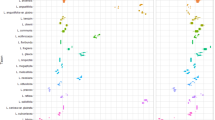Abstract
A Peruvian quinoa core collection, containing 103 chosen ecotypes or landraces, was defined on a geographically stratified non-overlapping sampling procedure. The objective was to determine whether this protocol was correct. Hence, a phenotypic distance matrix among 76 accessions from this core collection was created by calculating the difference between each pair of accessions for each characteristic. These 76 accessions were chosen because they had complete data for eight morphological descriptors. The diversity index was calculated by averaging all the differences in the phenotypic value for each quantitative descriptor divided by the respective range, and considering a matching coefficient for the qualitative descriptors, i.e., 0 for characteristics that matched, and 1 if they did not. The total sum of squares from the analyses of variance for the phenotypic diversity index, based on morphological descriptors, was partitioned between and within Peruvian Departments. The between Department cluster variance was smaller (0.0022) than the within Department cluster variance (0.0144), because accessions with the same stem colour or similar inflorescence type and colour were grouped together irrespective of their Department. This was further corroborated by the average linkage cluster analysis, which was performed on the phenotypic diversity matrix to study the pattern of variation and the relationship between the quinoa landraces of this core subset according to their geographical origin. Within each sub-cluster (based on above qualitative descriptors) accessions were ranked by their Department of collection, which indicated that the sampling method was appropriate for choosing accessions for the Peruvian quinoa core collection.
Similar content being viewed by others
References
Anonymous, 1990. SAS procedure guide, version 6, 3rd ed. SAS Institute Inc., Cary, North Carolina.
Brown, A.H.D., 1989. Core collections: a practical approach to genetic resources management. Genome 31: 818–824.
Darwinkel, A. & O. Stølen, 1997. Understanding the quinoa crop: guidelines for growing in temperate regions of N.W. Europe. European Commission (DG VI F.II.3 – Coordination of Agricultural Research), Brussels, 23 pp.
Hill, J., H.C. Becker & P.M.A. Tigerstedt, 1998. Quantitative and Ecological Aspects of Plant Breeding. Chapman &Hall, London, 275 pp.
Hodgkin, T., A.H.D. Brown, Th. J. L. van Hintum & E.A.V. Morales (Eds), 1995. Core collections of plant genetic resources. John Wiley & Sons, Chichester, 269 pp.
Jacobsen, S.E., 1997. Adaptation of quinoa (Chenopodium quinoa) to Northern European agriculture: studies on developmental pattern. Euphytica 96: 41–48.
Jacobsen, S. E. & O. Stølen, 1993. Quinoa –Morphology, phenology and prospects for its production as a new crop in Europe. Eur. J. Agron. 2: 19–29.
Jacobsen, S.E., I. Jørgensen & O. Stølen, 1994. Cultivation of quinoa (Chenopodium quinoa) under temperate climatic conditions in Denmark. J. Agric. Sci. (Cambridge) 122: 47–52.
Johns, M.A., P.W. Skroch, J. Nienhuis, P. Hinrichsen, G. Bascur & C. Muñoz-Schick, 1997. Gene pool classification of common bean landraces from Chile based on RAPD and morphological data. Crop Sci. 37: 605–613.
Mastebroek, H.D. & L.J.M. van Soest, 1994. Gierstmelde blijkt multi-purpose-gewas. Prophyta 1: 15–17.
Mujica, A., M. Rodriguez, S. Pino, V. Apaza & F. Huapaya, 1991. Catálogo de cultivos andinos: quinua (Chenopodium quinoaWilld.). Universidad Nacional del Altiplano Puno, PerÚ.
Ortega, R., 1997. Peruvian in situconservation of Andean crops. In: N. Maxted, B.V. Ford-Lloyd & J.G. Hawkes (Eds), Plant genetic conservation: the in situapproach. Chapman & Hall, London, pp. 302–314.
Ortiz, R., E.N. Ruiz-Tapia & A. Mujica-Sánchez, 1998. Sampling strategy for a core collection of Peruvian quinoa germplasm. Theor. Appl. Genet. 96: 475–483.
Ortiz, R. & O. Stølen (Eds), 1997. Spelt and quinoa. Crop Development for the Cool and Wet Regions of Europe. European Commission, Brussels, 129 pp.
Ruiz-Tapia, E.N., O. Stølen, J.L. Christiansen & R. Ortiz, 1997. Assessment of quinoa accessions (Chenopodium quinoaWilldenow) for tolerance to salinity. In Ortiz, R. & O. Stølen (Eds), Spelt and quinoa. Crop Development for the Cool and Wet Regions of Europe. European Commission, Brussels, pp. 69–78.
Stølen, O., K. Bruhn, K. Pitham & J. Hill (Eds), 1997. Small grains cereals and pseudocereals. Crop Development for the Cool and Wet Regions of Europe. European Commission, European Cooperation in the Field of Scientific and Technical Research, Brussels, 183 pp.
Wright, S., 1951. The genetical structure of populations. Ann. Eugen. 15: 323–324.
Author information
Authors and Affiliations
Corresponding author
Rights and permissions
About this article
Cite this article
Ortiz, R., Madsen, S., Ruiz-Tapia, E.N. et al. Validating a core collection of Peruvian quinoa germplasm. Genetic Resources and Crop Evolution 46, 285–290 (1999). https://doi.org/10.1023/A:1008636232584
Issue Date:
DOI: https://doi.org/10.1023/A:1008636232584




